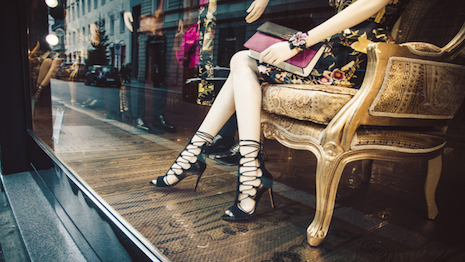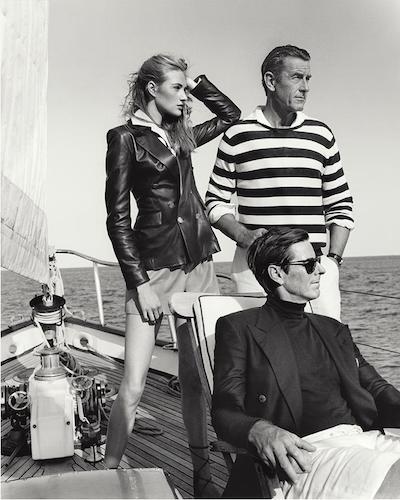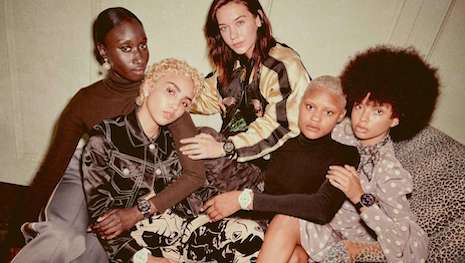Perceptions of luxury are shifting as more multicultural and millennial consumers become clients of high-end goods and services, forcing brands to evolve their marketing strategies.
Luxury often leans on quality and exclusivity to justify its price points, but a new report from Mindshare finds that big-name brands are losing favor due to a seeming decline in both production methods and personal touch. To maintain relevance, luxury marketers need to think small and focus on the new influences and mindsets behind consumer purchases.
"The messaging that brands put out is paramount for influencing what people think of their products," said Jodie Huang, manager, insights at Mindshare North America, New York.
"For the case of quality, transparency is an important factor for brands to incorporate in their content to help assuage any concerns over their products, particularly in matters of sustainability and ethical labor," he said. "Especially with the younger generations, opening up their manufacturing and supply chain to public scrutiny will give the brand a level of authenticity and help connect them with consumers on a deeper level."
Mindshare's research is based on a survey of 2,000 U.S. consumers, as well as focus groups.
Multiple mindsets
Mindshare’s report identified five key psychographic groups of luxury customers.
About a quarter of luxury clientele are considered “strivers,” or those who link the concept and consumption of luxury to success. Typically at the start of their careers, these customers are mostly middle or upper middle class, and are most apt to invest in liquor or fashion.
This group features the highest concentration of millennials, with 57 percent between the ages of 18 and 34. Strivers also include the greatest percentage of men, with 58 percent of the group male, and they have the second most multicultural audience.
Mindshare notes that these individuals are tuned into social media influencers and television, and suggests appealing to the idea that a brand is aspirational and difficult for the masses to attain.
Sixteen percent of those surveyed were identified as “trendsetters,” due to their desire to be unique through luxury. These consumers are also highly multicultural, with four in 10 identifying as a race other than white, the most of any group.
Trendsetters are also most likely to be from the southern United States than any other group, and they skew millennial, with almost half from the generation.

Trendsetters look to influencers. Image credit: Fashion and Beauty Monitor
To reach trendsetters, Mindshare suggests putting a focus on influencer marketing and speaking to them early, allowing them to adopt a brand or style ahead of their peers.
The “aesthetes” are most interested in luxury for its design. Comprising 17 percent of respondents, these consumers are 62 percent female and are almost evenly divided between the age groups.
More than half of aesthetes have incomes of $100,000 or more, and they are most apt to buy travel, automobiles and fashion.
These consumers consult brand Web sites and online reviews before buying, and Mindshare suggests that luxury brands highlight their design and craftsmanship in marketing. Partnerships with artists or other creatives can also win these customers.
About a quarter desire luxury because they want “only the best” quality and service. Skewing slightly older than the aesthetes, they have similar levels of affluence, with 28 percent making more than $150,000. Like the aesthetes, they also go for travel and auto, and turn to search and online reviews to research.

Only the best consumers are most apt to spend on travel. Image credit: Ralph Lauren
To reach those craving only the best, the report proposes highlighting a brand’s leadership position or service experience.
Nineteen percent of the respondents are “comfort first” luxury shoppers. This group who see luxury as a way of life is most apt to be seniors, with 42 percent above 65.
Comfort first consumers are also more affluent than any other group, with 35 percent making more than $150,000. Like the other more mature shoppers, they gravitate toward travel and auto.
For these customers, status or image is less important than comfort or ease.
While these represent the mindsets of today, luxury consumer psychographics are set to change as outside factors evolve.
"It’s less so about graduating into a different segment, and more about evolving into a group that incorporates values from other segments," Mr. Huang said. "Many of the mindsets and values exhibited by each consumer group is ingrained in their personality and shaped by the values unique to their generation and society today.
"As people and society changes, so too will these groups," he said. "While some will retain some of their current attitudes, others will morph and change into new consumer audiences in the future and it’s up to brands and marketers to align with these new groups through consistent research and insights gathering."
Quality control
Luxury brands seem to have lost some of their luster, as 73 percent of consumers would buy premium goods instead of luxury if they perceived them to have the same level of quality. With 15 percent of customers doubting the quality or production value behind luxury goods, premium players are going to continue to be a significant threat.
Big brands in particular are falling out of favor, as 55 percent of millennials say they have lost their personal touch and more than half in the age group preferring lesser-known brands.
There is also a perception that luxury is more accessible, with 27 percent saying the definition of luxury is no longer tied to scarcity.
Mindshare also notes that while glamour or style were at the top of luxury customers’ wish lists in the early aughts, today it is more about brands that show values such as kindness or trustworthiness.
Luxury brands must strive for a higher purpose in products, people and the environment, according to the managing partner of YouGov.
Affluent consumers have conflicting ideas when it comes to spending money in a meaningful manner and choosing brands that align with their own values. During “The Era of Brand Meaning” keynote at Luxury FirstLook 2018: Exclusivity Redefined, the executive noted that luxury consumers are making defendable choices as they seek to make purchases, which has shifted how a brand is traditionally defined (see story).
The luxury customer is also increasingly multicultural, with a greater percentage of those who do not identify as white spending on categories such as fashion, spirits and perfume in 2017 than their Caucasian counterparts.
Fenty Beauty’s entry into the cosmetics arena has shed light on beauty power players’ lack of merchandise diversity for complexion products.

Fenty Beauty has pushed other brands to reevaluate their skin tone selections. Image credit: Fenty Beauty
Created by frequent luxury collaborator Rihanna, Fenty Beauty launched following months of anticipation and two years of research and development on Sept. 8. The line of color cosmetics, including a staggering 40 shades of foundation, was developed in partnership with LVMH-owned Kendo, the company behind Bite Beauty and Marc Jacobs Beauty (see story).
"Exclusivity is about limiting a brand’s accessibility, and this can be a factor in both logistical and marketing considerations," Mindshare's Mr. Huang said. "Brands have to decide how exclusive they want their products to be.
"For example, you have mass luxury brands like Ralph Lauren or Coach pulling products from department stores and stopping discounts from hurting their brand image, or a niche brand like Patek Phillppe who only sells from authorized retailers and not even though their own Web site," hhe said. "Brands can also limit those who can see their messaging; by targeting their consumers, they can decide what properties they want their brand associated with and who is able to see their brand.
"Exclusivity is a fine line for brands to toe; they want to limit messaging enough not to be overexposed, but accessible enough so that potential customers are able to reach them. Brands need to have a clear content and channel strategy in this regard."
{"ct":"Mr4vo5nfWlhS14DD24jnHgY52UFguTSz6El9+ReDBhxY631tGB2yifuBxnmRypL9s5PtauQtd2TYglAPDWZuCjUqC6IDLakEabG+mdLSkZJBcHuLNCPBOiLR0wJVHP6NWac0jJaDqDu0Guw8BMd0jAgnhcHCnOOlSA+JYysULWfdX2892wNl3J5oy7Mf4Hs4+Qva0Kzup81O05KEV8JIV0SHIMMVxJgt5U9WomdiLtm57BTb853DlHUjzmGW7teG4lZEpBdFFGjIZSezyReFPyAEVYrLqV7v+uA1sbtWkgBIJ2yI9Je0zV0ysTk42CXxQGPrRTGZDihxluao0zGJwK3TxKuuagp4nC7avuGu8+vmfFf1jH7pQcScNO42+Y8CyGCKhFpBokAVv79A7oJVRnlT3ZZPXneC58inf0k6PIlej2K+upBsNIoi4rBL4S3ltfuANezbqaBAkZBIqfDFU\/JBO3S+tNdSxErE0Oc1KYmAVmOb9YEqlo8qvtIe\/eeoDCn3nZSOH4Xmh5YDoEanCw2ovmPOaZskMvElowKdIATLtt0G0MPvUrPIuEkya16OUfKTOEFLVhBszXWx0uUl04kQO5nho7GLmR1TK39Bc4X5a3StvvgEdDEUDjclDy2neHPABBE7GIIEto32P\/j7g9QeIBXLCg3t7DzItfgg6NYzi1Vr5q1dQCzZSw4o0Fi00PxxnsrXz3gGUyj+IPh+m6lYtZ2rBojd9YKBp0oSM4XQ1BINIkOfCyElOgYCVX4PoheI7ERLL4WiRknKUrvKs\/7C2LWWK3x5hfCKILfY+bM9pGTqs7lLB7cSROsgkVnpO0qHkcwos58U64z7DuTWlMkPsOjPOH2mSDR19Km9fkTT2261EDg8tqO\/v5947\/Akh1Fd1N6rS9j5xwAi+SoP2rg7K0OZzN85ShphrtTXvSqmdsa6wkYPSTsSB0p+fwyzLK8IK\/FMR6CsO8MKhVwkcQuLL5LtA7jevK1iNsyQc66Z1nw6\/WEtKlkGahEuZMUH2qni6l9XhXck\/Nu6TYFF\/Z5pEdc\/fo530kp8thO9nL8XCrVOdy68ZJE8dSqD1Mf5aZ0MNrP0NLXh76hR7yWlDcNPRx6mAleMccEld24fKyrp4JiKmXMco945zQfejXdh41qrHKTozC29g6eVRRWtyTr0uN88KBMjTJFHZ5ZLY3exLB7\/DqISYMFP03vta1Go8j0viYDxlOJ98Imn7ux75diD1sCDAiq\/Q\/qyy4jdI4M8FV9I19gmMSbmLixkk2ukjmOnV\/BZQWLTPR7LQqEvik5GNYmUlC9xkOvNYJUos5Ow7cgIbKZWyOyv5PK5+NFzc0yhAFJU03ngVq+Uja9pWCvDFmHRTLoqTn16LFkOoGvHQJLMzSU5G5wKGtZo6E2wNpkWGJEzwUjFnhY57VvpDQdFCuIrIEXda5RFm4s303gFUINO9M5EqXbPwVoogYA66WmzoZmNlfDdi\/Ls650kZlCxhhavLI1HmGG7jRLrIowLXIjjv8PMgFb\/Mx8K9VXFda\/vndIjaH6KeBkXQQnT9fV4lG7VQbtiWZhhYJYzwCVgrYFXjcvoc1OpUcvN9tgkNqt5eJ45zXE+xAvvO4Nb\/xSx+uJ4NcUO2Bwule9i1kgZMbQUhS7e1bbE6D03HOyRUA7HziAfUoGC6EXdxhJP4OIuBOgF1jNPFv4LMMcsQQ4lHJSSyC431J1XYnF9HFNKTMPLpWchV6cMlm0psc19RuMGTcXjQ9YyxL\/zmsQ64bmlyAQSFwS\/Z7qzRfDDGXa23yZGPYm3SMXVNf8kbFCiSEL2foNwGGXzA3apxt7lnjFeFgM1Ukn7q9KR60qP8Iv2aRaDNY4eBB84QFB0ZvCFsTup0rHEMWtCd3ltnS7gonWWgGbDYgTuCTIGcBs2zwR4doLjvG+ShGXrMeBT47fyusG8Tqec1kXBByJUw5xLCdBZFn0tv4e0+uy0paNbyPoAHj0iTs0gkjaj585+n3\/OL29JcHXeY7PlRPA\/JOPvwD2LFuugIn6xxOLDSkgB1dbTC1OyITFIZOdCapzz40PRPi5hfPXR39hGtcxabx0TH7im6atffqd3anlIvOPD4WY5zw3+ednJdF9pRYHZ9ZkY77dD0eE00eK1Z3Yz\/np+ROJH5SoyOqDUBk9aVSG6KiqNm48T3se+lXRhrcYQnTHFH+H0SgWTCVXFS2oi0zipU9Nuuy9GzGrp3RGKttZQcXs8WNKMOgS5UFFKcp+Wesl1NksULi0Hl+5RlEipO+oImb244DrV5nNv0rYGEHpQGTRnmoQJIG\/QSHPN+gnwiNwX4AXM6\/5tx+pGqgSKdxqYT5IgKmbhM4FQ0W\/wNlxfG9GkselxP6Zygy2s03wMzpa1pDXjNpPEJBEmKRK4BeBvZdI6CybunrkHRkdRx8nf9gL3hQSb4MF3mmAxhb9cEUzIHXQb0JFr9xULh+MkAEfivS9YDMNC44sIfMJqi7U533ni5vWTtGDMllVVnMDNrAVio9SiUVSQFTbknSZodlCGF8T54ugH5g1tSZbT5\/YgTTNzlqgi3UohgyEl55BlX6guTSvehAp3kLW14fpv2\/0rfP2G+OaHUE4l7fTuurTd3Zy3nqaxR7jLn\/HVAQbXUZoKnI99x\/DvcAJ4pLX\/S+ASNq1mdm09cenfwtNDxYF9Dk6iLPxAaHHaiBocx+\/pbYa8xa2uzZjy1A2lhpCZX03LlCFwpsj8gExg\/ucwzWd1L9Qxks5avndy5FdIYHp6XM+98iY+jz4cs+Kw+h0mY7MJ2vgE3LRoKDxGCnAC4J81bZOtDWVQk505kjPfUTwnOwRpCnpG\/v6p+8On3hd4k0Nx2vLqmjRdHty5MOqcmY8QG+CoF2lXfup+GotQtUh17DhxmdQIXgoO6RwuxgQR6QUFDm94zwPpLDsLDDdyB90VojG4LtRmr56ZahXiPfPFV0DWzvqW5UNVOCYB3BxRyuDfLmQPyjCbmA4lk1qNn+Un8OzOV9PEtfUPwDgCfmrVnsoSj+p1rUjb8TW4T7yUktxFBIo1bzCJgJy00PJfB4UaB0GrjyEB6A8A0eXPVfXrvFf3PpjFHsj+2VtrFkztausH1vNarNRoJqOQxdTDknlhj6hxfTcWvnR\/mEd18hVXX3uXlos2z9RZaMWDx8EEjj0OxVqxbp3i9XadFwwffum0Jtky1L8Wj6yfgDze7M64EPoJVPEvQX57Bx2uqMchQNrLSY\/vsRhE3l32zU2hUAaM6CXG1BkhpnZOT2lmdZa6xwSpLoGlYwsysE3bCu62tQ6y60OR454Fq\/NRsZN0h86qLHf5CPnaUYxv4k1xhgLELVvQVcL3doV1nyGFtKPslBrx7JL2x+w4YnEfCQ2Ez7AffSfuLw96j533TSQdgmCLeVskgOQsPztKAMh\/sPtIfLTTvMEBzx+K+yUv7\/+AmkSqcNGDeXOMsx3VB0RU7wH4MUd\/psz06DylpyMwb1hTDvEc3d10RNZF1vbbyPdAGERedjY+Rkpf9RuXVk8yjQcZ+4wGjnSGEICQaBh3WcWEHdGvyx7hi5Y4VebbnWyOgxTRl0zWSRa1d33Layqzbo2rWlzd0ZcgrTSwzvT\/mHlV4Z8XpYhB5kii4wJizsHhXaEY7jj8l9K0Nwv9sPf1q0FvjNznDfQ5s5l+N9uFMB07nHVQLLtQOfiNg5rFUGEZQ07gB\/TKVjt8XdxcSj08x959XM\/AA6hunP9oOvBLO8LjJGTFYjSHQEb3CT3LOobTidL\/Dg8sjyrBM2YeMEVCxMTw96jND8W5CAK6fnEBK2H97yCPkjTpxjnFHQcF17\/t51WMjTO3dpJmec7HbdP+o4iE\/v1zw2r9HJioWzs2sTJ7YYrVfPq4hZZJIaY0YcpavzAFQrR32TvzeXQM8vSgXX9jBZBIrrGT5EBGB+X8p1BNb9XIpMbBde+2zh7SKaXx2YOBF4Hm3VC4aJzKI3o13RMtGtjJOo1cDjyA1ZFsD6PdXi2joGW+KV7L6TDSCx9WET4GTjlnxvF5dnb2NRqO3PWb9KGTjPjbsQmzjSvUnU9Omck6UzIRTwU1sh0E26ApaBFJD7DB1Euq8M5b70WL24d090UbmyiuG8PwNVRzIYVQsEu084Kk18T9D3xi360GjM4MQbQ6UKktmawPtWhqQG0WpVpzPZ4xHyMFIIA+AIejvU3v+tBOY6o81pYkxrSaOfc9ZHcri+rl12gRmwEYhEG0Rd\/KKcaf1ctk27wC9t49ezHu+Hx3Et8eyy9DEi3Wy7UeeOhVbLVVRMnzmlyQ2SwwLZgtMzIq1wCxnb7GcSxRChjONHE9NkHqEcXebY2+3J9+NcyNqT3ftujRlUpL8fuHUxSPr7lRa7LTVbqAXi\/v2xFnP8yJkpxKBoCawIy8B3rLtlD4\/ScoFXS39rk+gvYQ20Wmy2HINn+0rO1xl\/5Qmld8vy1\/TZZloOVhoCorF+UiS7\/hRgM6xLWbEBkxU1wruT534Qoxapsbkbsndnr7uU7v7\/x+TdrP4vXa8BKGU\/Jz0RjCAvOumcQ\/2P7jvud7RwoASDsmYBtPSZUFIEW+oWOkloubfa\/TmT7CZey4INhtIsp3+0Wmy8DFaciKorV\/utaMBBgCeqVL5H+uPNt+wfyF6c7m8yPMgnvqvVBeMSX8B1SM9wqVZ6QQEqlGgicqjNOMGnkjJhQtYsy21b5mS47I8uttAuVE7n3Dtmc\/rYwZZRtZTfYB1p3HuQPDr6csq0b0c0HFDtvsLLlOx\/eXX4MJw8VbmXijl2T\/ab5Zjub+0zdbq1n5lxvMJiUBosrp9rBphSM57ISfSz5KWbWqlmMTNcdQhCtL7uLLidlueiHBqSqyLBMM10DBNuFJhHIbdqH0ldJgYQ\/s1K46k8\/nN\/SWbx1gViVS1yH0lCBdr+TS1o7hmXrBHZDvClSuHHc8UtqUAYrjfMnimRAV1C0pqNt495R7LMzLmz6E2Dsfx+Gpzzm6G7cCGI4DcZxuCrLCs4tkT\/+aowzy9CI6pTjyPw8XzKsrFFj48VPb1Ou5ywhI4OTzTFQrrKX\/WBZl4QqhlHCZUPPkMvEPvuYSTqmtm47Rb3EPKB9SWCb7BxEGWq6rrMwLT2kVyXUv6CsCVGzhCzpJcP0L3qEUqY2PH9+wKN+DeVn+dJqMQteHMWBqQnCRJ5EZht2zWhNT7NpxbDad91x5yzaswshZZh67a3\/G2Cha5PPDUpC7k9+UHggOhZYy756\/fra6g4Mczy1rX+BDhyd3aVrA8OckLCV8AFnbv4X+902NbW0UxzJOSQmP\/ujILTuHjHwOzFofoG+nhxj0GITDO9yhDel2PP7QZ8eSKOQPbJFbaE0oi5Vq7rPjTrGlFp46VPpfozqSOD7JB\/WRfceU5mBLS370iudCg7bv5Fft6DAlH8f7lGeRTFErsMIlWgi8JtvHoG648kaPDpseqF8T3gMElNujAnazh4BWPrOtaTA2rDsTckP6SBeUL29VDOZwKGLvabbsTmZil7la+BAjScvAM3od8yRD4m2V9+KYElTs8tJVOzAoNmzlnYAapZz240B36KUBhXkp1FHuQWkTW2e3WW9cpd3myU2xme3QY41vpT7yqbfGRLEHRDaTnzCUWCZ1jSOWEhzz+ALv7SGSQy98cdImVEiGSdrU9YraZy9g1oyGaH7VG8x6\/ehG3uccyAHoOINAVCTfENzaC+L89O3xFijOAehzq\/bheuFWJy2x0dUGZSmgXVIHop53LHV1XLT7cgX08N3SGlr6ubUSsHmwfNVwMLf\/UbufBTT0EH5Yj8FAgCZp8SoY54B0v6FDbeqYDd2jVfIKxITqsAXkX2lWOmbGoBQy3C8OJKbuCT03t2fOWhAuxfIDa3Y1SwIpIMeoGpoP0b4SsesVKXF9YZ9UUh96E2RiqSrLwEJdJj+vpjQ3Y+QAoNWHXXImYnhhr1EzO2G\/7B1QfNKTLAdvRrvs2UgMNHTI5uh0Pm9KU52S59gMGfoSt0aJgvrLzNW7oHoZaGHKnHx2TMkTPH+s15PRak13nUN2Nk\/uyooNknlJTOQ2\/g6F9Zl\/Pcd2I2xDYcbq0sP\/JQBDnHhEucNzXPTb3f+KFYBlcrzoiBY1VryMghdlDoxBvz6MvRo89T\/OANudCOWRNLPUTcTQiqlT8Aww1S31FDkKmkyKWs0x1jOTCxBwI0kO4UawMPL7eKGrC1\/GQnK3OQn0kp4XG\/xFYykjhoOvCohRS1jwJ4yCN0ZBWB0MejNRqUH+LJZd0EgrXgbhWjkbUw3KfpjwlKDlO\/YWoLRmMJy9zbTnGZJqu4Hw1PZOhG5uR77v3HaNaonbv2Bo54zPhG+ACszyHZRFOwa+mSMCMeXHKMS\/5DirTsgLhVTY9KrbjCNHoR27ThzsqiqaQzM2lBCVM1Y8+qLs181YxMbjrZqVh56EqZ01g5cv+9nGTQguU7aPdsEr7Ie1LGaf2yYMTTg7mTSf1f+iUoFRPpGzO6aX2ml+rjaZ9GoDTYYe9hrX8Vxkx\/lPA1xgvCWfHH5wOuzs+IrGQ8Bls0PtTpmm\/aV3d8qIjPERPDgQCHEW1Z5WKj37F\/apG7RE1puct4lfvJWvATA2wYcoxMd4YpqhKuzitqBYpuz0LVxKJNouUAZGwYdECKzP\/rx2X8w4vsKyUQWf73dmaIqusF0FMzc4l2gK4H7pikJgTqV5lIFptj2ZSkHbBjYTvhB8Tw5+BO8JgIqhqQG7GjWp8Zd2C1uwnewkFh\/909+XQvAocSb7OyeWQ1uME5lCrn7e2Fn\/PsKHfP3cEqHNNdNxpMP3nz9FEb+z50Ycos7W6trs17\/xhzfX35DFY6Y5YIUMZ74rtjhu42j6o3vA9izZ8lnjrhlM81E6Q81T1ci8Kbbao+TDb\/orgkR5TXamVhR3x10zIUjNbvq90FurOCK9j1JtOxokUdDB0G6Wg982M6BQ9VE53m7mc4nlG8n8YFmy3+uJkl0qhtJ4W\/Otw5HKP+Gig33+OfMI9hJKiydfzPLCEQe53txqDdz0wafpzgMEzDOmiPOhw6rW8tzJUVJrzuAh4Yfiz\/iq6qkPOTFwlyaK2lq7FwLSG1bVNVCfRDxSl693h2hDgAsjk+1vP51XqX\/eN5UFPLVySIccCZ\/t4SZSbqJ61IeZir40USSEShCkBpdDSqZBEqVpz6gD1FvCrV9aLilPo0x+dAo+hC+Y85Epogbf\/zxVhKlNhpRH++loxR0+w32Sq7uhnXsjyEoFN2iywKpLVggSW2w1v27Jw\/s5EQlYNfUJndAtQzLCkieZRZcZBOykSOUCxKUXEh0nfwkDUs47EePkfyfkFB9MseGEJkK4uMwpZZNZOqyq8B9GgcgrK8a\/xbf28qNTOJOYaJ91mYsas\/SLjc5aDwd0xSsDutlbRLRzdJR7y6DWTtKBhtWB4\/fRVJ5s6BVXIIPqZXfEOX6cuPLDaRoar+kJOupK29OdFDXRyrOzRHChZafU88sHLURPP3qWfc5ftdJaAkOPR1ehyZ6aDfG5UdpbuBeUiOjRUAxuAcftj8UNAdBfCWQfipVbz0REw1V8aJh0S7BqO1+5W3CDGfCYdqL6AvV4Dsi+Np9wxiPNfrxcXHBN\/5VHYWk\/Z1hITakqmK4\/h9SIx3HAuYU6fN0s42bvBWlnLr1kBpLaAkYXR0P2S6tChqpPv4YpfWnkZQtf5so13hM9lfz+5OJ6\/qvbd9CI5f6b2ZjJVF5Fx\/dWzYUzR6rCaBMHKp++3JG6f2X9krropwmvrrkofF8UV\/1A7prgHBINZjUou3oTJODTYbQ95v5l2hPE\/08enMiCrB7iIH0FEFDKDRh0xboWBY9WiAbPbV6t7vzpDz8JEh9tM+KtJ4mTKfCOVRC5iH3Q8cTcIXQc2pJW9Yvl81KJ2lwQWTapiUKOkBFAJQYFshxzy\/IVVjYGeOxd5t60e69rMwxI15ZEnl16gkXLINvzgkhh8s4kwSps5bPv83X8jRCU08mWyzs0XouYPf3MiPCkVJg4btbdNH8FAkJsE8I4fCIao5cFWHV9DA3Ek94eGwf06VA69xdyI\/OLkKH+vfJ2lKJ3aD37jDScOLRTDZHPdz6118zCoWR+73ec84wGBLYjCgfS0cxNwYRFWALVo9spOrRFqVEVRBv1SsffjYbzelYZ4cX\/A3f1XNOLCZlP\/wrzMjHpRMtTyRBRb3fSOKr3RZ4lDN0snWN7wx5cJP3IGiPnbhHW+MTbrEApafxRuDPDvdCMJc5ebyuHcHeDlm9TheNLGxihZYRi12G8yf04C173PTA14wVAz6mJyybibPMY1FHepT717xamHZPDW3eHVsznKVfOOj7VE0RrRD6dNaVo4g\/+2bs4DdWgjXHNvaA\/SoUKbDB+WnK\/1fhrkhPWQQ5CeuWB7hbJ3xgDC4lNxjnWcMaPCFv63csxXedEC+4xbBSjBteOQLvoT9VBHISnLLhTKglDZImtS9GtUA15+J5ZzDpNOT1VowWw4zNKDRRTbjAaiiNuul7UFWxOBHT9nSVGnJVfdxAW+ReKJoofcRcrMbCMmfMGL6hRAy6+EMD6abzVADEXeH7Cwost6JttA\/0McreumxA8ZNx1BXmTauIqXcQB1yzqfN6cG6LICNhz9H8emjEUzlvTe7FMSfXHldlIFpUYQfnD2udwMe71IkEFED\/dZgCDpqrCGnbDDOunkAVRB6UR5aleHSpd5NWCaGvlk3BAeVeciNvinEZksvKPhmD2DDmVPEjGhA8qE5qQu2xFQqqmwCPk79gIDKNZ+roJFxumjWb8wxjn5g+v+JOZxppbzQCfvVzrdwbLkZadmAWgJrtSMian\/Iz4SNNu0ii4VpFo+hZxg06uppe1ESdO7fN0jhfTbWHExsm6wkOlpHiiXZb2WD24ZO+C1CF76Qk9Lzu467A2BJghgTWouN6Lc2XWbFZT2kr6eoiDsCoIfKCwqLFvJFSPTS3k1RWS5pcfcNclF6tkWuBcRgK5BnEtbBPr1g460thdOY37VvlbNPVrmAP4lT3Jk5sbVx2+kxjCXaZqtWaUTMxnrLS3Iftm4468cAccraQwa56HPyLAwmpIedWH64wM\/s44MhjeyEOPhaAvU6x\/KlfnC4CisGZQjFGC9muIWk0lGC6OQi1FFnhj5Hm7chSeMeqRcHZXddqglQ+R+\/NhxezBJ2Zdzoi6s63lG5pv35\/pB7EyP+TO48GJgTJM6P\/l5v+NBiPMHwa2LqWhajBseRfLNekrYIwlqlCTqBvYxifzUTRqo5wwOaQS9qN0mc95WdOEQBr0ORSc6KYIHXRZi2HD9sDFXxu+27a\/KpwM7fKobnngHZXNL4WR0v93RRFsiRaa3Nu3LOJL0MV1XzNXX3ajetc6fAH\/pif4qSjRRoSMoCn9AVmy7EEBFBQ8rR0QdJd4kPaMPOUk0hTtMr2yxg4IN9+3NqSBnWX3zylv\/k5dB7L5wQr9U1CLg6WxLqpv8EedVotvNiEMFYnEAvAxEb5diEx1R96hsrEZAJmghVXu\/a4R63BqwhcFrnUOx0uUvTUkA1VfqMDuamTOpSyJhKrLW2bjKbeXo92zyE450cdmMteb874XxV5Lhti5AtjZPWjcIkzCLgftdMHG+rNEV9NM4Q6LXLcwjRdYFEjU6TT6k1edeHIBc7t8S9o5xyCN0lh5YUVD9URyOUQsvIJpwLKGDvWJfwDTZ++2nJ9Ux7L0Y8qaVkXgOts5n7x\/jltrODghyWnSy8wCIqAZkAZgSEY9BcDTktYsRT33dTgkyPLJFcglMbz4z5ANRQceRTXgWTWSdJqWCwbG\/ZWpzCHFJHvLU4Jgv6vqBAGo8QHgM\/sC455DowaY9TxipPBpe3v6ZfevHcfbWXdGQ9TwtatS+NlMXGDr5ans8sTFzgDVrHh7IUTIMqeqiucw3W3ijqacGQN0ojCGwlHwD\/9Knyklq8Zlk3sYntN07srN754kMrT6IWywsawtMo0Rk91KDsmLJZrMOq9H65XjGw+gUfa5lfcbxb8oo+3rKjlxiZMYpKjLHBBAW+hsBMhxuNgNhCiH1Aqq016Mmp5Jpkf6pcYDenLJ+jl5vIqc\/tWZngWKqpxtCPeJVD9UaieoqYs323nf1XJESz9jbEcsFrijpNqZ0BceUcm46JlWT1aDtm2NN5syh+6G7Bl8u+FkFaC4RqsSE5Lpe605xhf27EI2fmRV7BC+ltamadbCO2Sd56aVrBJ8Hn\/AokV2URlv9OCrEBUVXKa3JXD+C8VzUh+wZ55qYnaidoCSoZe5ekYQDcNYAi\/jWIPAP51vqNe6UdooNOLr+pDDkKTPLHEz88XvDXh79zj52N1baXH7m6SVFkvsg1EN0XsCaTgf3aQgda7oTqvuqP7UXRMzHkdV2j8lTRCynaVu9LCV3r5eBa3GtVv0OTUlYp7CgOePlywhBKCkMik9cuHicCrkviaP2za4VKvUHvXpi9og2\/YnGBRia8dKLu3Nb2x1qw9reJgdKtzmy4JptqPPEBg3yxRWz4VyouMuGdOxcj5sVqsUQz4Y8big0sVDW\/XXHl4IM5uMeZlIJbQa7KF3bcIWvyOkjvRi5GhCK9hLgzD5EjQ5oU\/1eAMDH3+\/XmB8SJ4dbxLgSw9MNBZmTtoxvfe7Rq7VA9bG\/oTGLr50M7G1juKnHAvpyZtfJxedqg+Dz5HsDkSJ7uO8P4G+1WPG5eiQUVKpLBn7fN8wySXdh60FxqClCkQUZXMsOGKneirDZ6hZ3SE1d5azFtr1Tqn5QecxbUwV3IsZGZmySylMqlPoZkIiZ6ajZgcqZF1cKWKMnHwNxBh6l2P0egV\/aX4FVr+GIIPcZqH2m1xjVHIHaoA30VMEpPfbA6q7oqWAdw8fUzruuIW2OIps2seSyFVaaeAvAuJggTRhjG6yFum2zoQGdZHCj4q1\/\/+uBGD7LI3YHLiA+aLxdSbwksCxt\/\/PUd032otknBq1XuKMYKveF\/lqlUqmAe9498Yz+oi4MrKPm4LH7+NXjV5Qd24o7L3Z0D0aLY9z7AUCHalf0E5PI6N6lkLXPsK4EqpphKu9TX4moYmlhuPgsw8EposGXupPa9UxohoshJ3boi18RmyS+ha6YgORL\/7WDq0f4Y3b6WEIyC9atlRRFnjGMMcH2s8tiPgO1um6TKzaMBUuntkPUsd7QGHBetge\/CBjq5xfXbRXaO+3hEWYSHvKI8PZ90MCCKb8Oy9ko8GO51mC07I+Z6rPB2wekdLCVq5zgCa7IDHJr32Iqmh4cEKY9UoFJ3VwDNNXWo67AyLPApoYMjBEk6HwmYQ8SKbn2bB0Gb3wIudL5g+jPRhvf+4Cy90tjiOSV9cb\/mHrgYJDu\/ZvpCLP+2tXcaPO7ApV5Dzu8lercjJRkTYp95Fl9QM7LNySZ\/x+4itlES20z7O2eOO\/iNVutnh5ukjzuSfD4i7EDl47BfdyAYbKPztMHEJueHv\/aJ75YWgVVjj8JEjTJob7T1VZek+biUJNJpRLSE8gyDMic59gHxec7YHrJu6QUWFkaoRHP1vvStKD6EJYSdEnLWWbdQqOMrst\/bYFyxKlOr1yktHkJP3xWl8T077xhtCKpCfSvxHrR0Km5QvOFiSByJ9t2UghxTv727VLyrqNZCAMhmiQzNVHIQBWk24lcLd8HEM+5zXOZCqmDDlQSU2m\/rZ4FOizY00ddG\/h6nljyleyj6eqMPYkHGcp0pWcullUpXULO\/1b5GaWrmspwfJ1Lm5ZUPrgAmqHFdw5A4Py4nB3gmuGgvK8EKiJHHU7fqGJ6HFzQgV95sf58EO0js1gtO990uIPzxE03Xu\/ZvtROXXEpBi8hNZ6BDwevchZvKZzVupPoXoq+e9Zc+DtwSGsXfFWwOCfoYtJTx2uVaWCsh573K+luKibzfDW9qgzdyu4+bv111EN5\/euMexODBRXdvxdNlXd9dtEcJzkexpxRyFJ38XrlmW+0MsZBb19AHUyEQqhTU3VTv4RRu9prQZgnTB6jFTtZdKQpyyrbwR0JfPTY+uViwJzAQuIQ3LdcWHZYD\/0ctTH+3A\/8w0zsQQuNlf1S65TGM2bI\/ChPJflU1eLx91R3X8sq3R+Smp2Zod2S7txBRGcPNAAUw0NdNXLFGypW9C\/8Td4bKgT828K3nUkNXwh7gt0eV+SFRuLuyIvxEfYb3\/S0Lq77gAgPL6f0FsoAih7HXamjyQNzqaLiH9cNAoHC2hag9z1Fmjv5B3W6G46OH9Z+p13VB8rI+JFf1Xx\/OdP50EFNoePsB+zlgWMwv+lNB0YSaF5Mb7fAuM+GTj+Ul0N+cVQ5xCYW9d09vVnN3iLTlgMoVSoR0K6tIZm7dTn9paGc0nSn26+DRbChmDpK10TEOsI9h8epePozwtdxp96bG6aE1gmYBdvLMbTR59SELr7YnGwMw9NcAaKfbksD1WwUl6yCeU8h\/ZyR3LA1x\/60Gx5VwMUWvnPgGXkJAPPktvW6bPp7yLZL+spK96YSQ3y7ojNn8L9qcscMVqGZYC\/ow3Yo4mQ7oaEJF8dbTPaYg60FUUrmeSyQAqK7GuXJ\/31JPCkUHbMoTb9pq2u+pPEF2vYa85Tc41birA2y7bCxX\/hz7fWNBIR7Ohu8ghYockwiP86ex2SAnbqlB72c6rbD2XMhvvMp49LgXWyLc5qXRGKm7ZBG3pDf7w\/b\/Q8y8O\/D5Si\/LrSSqcGx\/v9\/Sc4sq1LCi3sCkxPhUwkzt6yuttnUoEVrt4CJE13OwgPzk4W3lLgcmKV\/qaREcdcMfXQWSpHHTxNqBtJ4y57HSoLljwMmmegekK00gdYHPgbvLhJkBzaIB8KVSs5mGWTLcdK\/x7XWeEM0RRs92kay4lP5u2voJW3dyZ9M1HLMiy4bHp738HS3X8YZMjxy+6kSVv83KyKdHNUAC1I9hnNl1jDQeCLuP7KhV3JPtPHvEkkij1IJvR5vPLWET0\/gfgf70tXDWXlBBOsE7OpssH7mCPBSwhX8ArnFHnBxnWaDwol3jA5M3V3JAHsHrNms\/Jr\/Z0Wcs\/dJT63UrNHpTUpo1CwwAxlOb+y0z6eBVtwiSw1fZFCpBuf0f+p\/pyT32WJ46fOtv0IqHIzvwg7uPEuZpaG7s0hxAqm1fzsZTUb9Yftufcb2lxqQHqFjWn484r6yRMGn\/6wjooEJ+EI5FISL1O\/o94t5\/039yctG2DY7WU7ZwJUn4ElptnIytuyYapaIAY9dNU9cqDrUtwJBJOS6l7AyhOLIyaTfmyfxTlhDQS93\/i2SaszCDbVjcOfvaP8cDMkwjkIz7XnRZhhMqePBJYChZ7PzVaR3xdjzqv73NRyZ5ODDysrIWy3sy641DQvzqCJDmsOTuhoVXHlhaIHZQO9fq3ddNwlO90Cb5nV3Ct7fSzbkbhJZmxr58pIn3OEJNRZRqF2nxL5vieDTLr46J7Nx6aIz8SSTyNXAwiTTj5Xl4QX5wujNOy9KWfgAlQd6CHRugJnBRvmMUnjd6OJ9Eh4POVg2M+kg9u3TyEbc9zMz03Z3yfn3\/Y0Dz73QumkZ6DXjZ2INcPhGn8dwNG7omFAnD8EqLZen2lBMNrzawwA+eqM+M3q2nbxpNqLtgoasxEGtq93HE6xcyJlUxejDrJHkdKhd4wQPzzV32EEW0+E+91GjW3kQwjJH+RrzEVFPrNDwIZRE+z5t+sND6Nuk6frGnuzmatP13nGer6x\/tpkR8awy11TJ9\/fV7MsTJF7aRLQcVhksCWnG5cKTH3VEcnOVcLdmi8F6mRN","iv":"58a16414c3d85fb78021334a23e32c29","s":"6b2fcdf2dbf8937a"}

 Luxury is increasingly speaking to a multicultural audience. Image credit: Marc Jacobs
Luxury is increasingly speaking to a multicultural audience. Image credit: Marc Jacobs